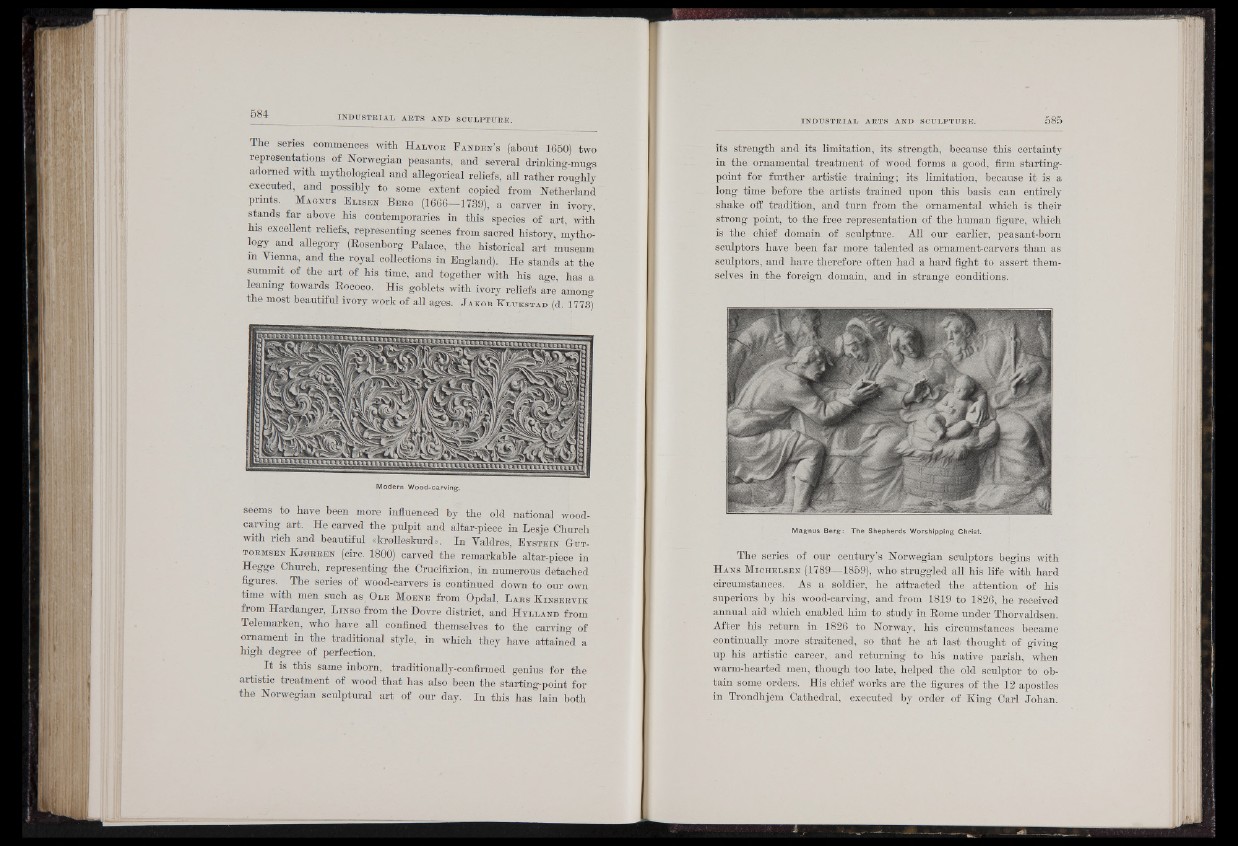
The series commences with H a l v o r E a n d e n ’s (abont 1650) two
representations of Norwegian peasants, and several drinking-mugs
adorned with mythological and allegorical reliefs, all rather ronghly
executed, and possibly to some extent copied from Netherland
prints. M a g n u s E l i s e n B e r g (1666—1739), a carver in ivory,
stands far above his contemporaries in this species of art, with
his excellent reliefs, representing scenes from sacred history, mythology
and allegory (Rosenborg Palace, the historical art museum
m Vienna, and the royal collections in England). He stands at the
summit of the art of his time, and together with his age, has a
leaning towards Rococo. His goblets with ivory reliefs are among
the most beautiful ivory wprk of all ages. J a k o b K l u k s t a d (d. 1773)
Modern Wood-carving.
seems to have been more influenced by the old national wood-
carving art. He carved the pulpit and altar-piece in Lesje Church
with rich and beautiful «kralleskurd». In Valdres, E t s t e i n G u t -
t o r m s e n E j o r r e n (circ. 1800) carved the remarkable altar-piece in
Hegge Church, representing the Crucifixion, in numerous detached
figures. The series of wood-carvers is continued down to our own
time with men such as O l e M o e n e from Opdal, L a r s K i n s e r v i k
from Hardanger, L i n s 0 from the Dovre district, and H y l l a n d from
Telemarken, who have all confined themselves to the carving of
ornament in the traditional style, in which they have attained a
high degree of perfection.
I t is this same inborn, traditionally-confirmed genius for the
artistic treatment of wood that has also been the starting-point for
the Norwegian sculptural art of our day. In this has lain both
its strength and its limitation, its strength, because this certainty
in the. ornamental treatment of wood forms a good, firm starting-
point for further artistic training; its limitation, because it is a
long time before the artists trained upon this basis can entirely
shake off tradition, and turn from the ornamental which is their
strong point, to the free representation of the human figure, which
is the chief domain of sculpture. All our earlier, peasant-born
sculptors have been far more talented as ornament-carvers than as
sculptors, and have therefore often had a hard fight to assert themselves
in the foreign domain, and in strange conditions.
Magnus Berg: The Shepherds Worshipping Christ.
The series of our century’s Norwegian sculptors begins with
H a n s M i c h e l s e n (1789—1859), who struggled all his life with hard
circumstances. As a soldier, he attracted the attention of his
superiors by his wood-carving, and from 1819 to 1826, he received
annual aid which enabled him to study in Rome under Thorvaldsen.
After his return in 1826 to Norway, his circumstances became
continually more straitened, so that he at last thought of giving
up his artistic career, and returning to his native parish, when
warm-hearted men, though too late, helped the old sculptor to obtain
some orders. His chief works are the figures of the 12 apostles
in Trondhjem Cathedral, executed by order of TTiug Carl Johan.